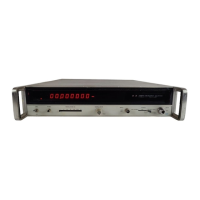Model 5340A
Maintenance and Service
Table 5
-
3. In
-
Cabinet Performance Check
1.
2.
3.
4.
5.
6.
7.
8.
9.
10.
11.
12.
13.
14.
15.
On rear panel of
5340A, set SELECTOR switch to correspond with the line voltage to be used (115V or
230V). Install correct line fuse, connect counter to power source.
Set
5340A controls
as
follows:
LINE switch to ON
RESOLUTION switch to
1
Hz
SAMPLE RATE control fully counterclockwise
RANGE switch to CHK
INT
-
EXT switch (rear panel) to INT.
Check that counter displays the following:
10.000
000
MHz *l count
DIR (direct) annunciator lighted
GATE light flashing
Push RESET switch, display should initially be all zeros, then display
10
MHz.
Slide RESOLUTION switch through all positions to
1
MHz, noting that one fewer digit
is
displayed
for each
step
of the switch.
With RESOLUTION switch
set
to
1
MHz, check that display
is
.010 GHz *1 count with the GATE
lamp flashing.
Set RESOLUTION switch to 10 Hz. Rotate SAMPLE RATE control clockwise, check that gate lamp
off time increases. The gate lamp off time should be
at
least 5 seconds with the SAMPLE RATE
control fully clockwise.
Rotate SAMPLE RATE control to HOLD. Check that gate lamp stops flashing and display is held
indefinitely. Rotate SAMPLE RATE control to mid
-
position.
Set RANGE switch to 10
Hz to 250 MHz position. Connect appropriate signal generators
to
INPUT
BNC connector and vary frequency input from 10
Hz to 250 MHz. Maintain the input level at 50 mV
rms (142 mV p
-
p). Check that counter displays the correct frequency for the entire range.
NOTE
When making high frequency sensitivity checks, it is important to recognize that
cable losses can be appreciable. Amplitude differences
as
high
as
20
dB can exist
between the generator output jack and the cable end connected
to
the 5340A. When
determining sensitivity using generators with
a
calibrated output meter, include
cable
loss.
A preferred method
is
to measure actual signal strength
at
the cable end
(properly terminated) using a power meter capable of measuring the signal of interest.
CAUTION
Do
not exceed
1
watt
of
input power
(+30
dBm) under any circumstances. Extensive
internal damage may occur. See Paragraph
3
-
22
for a complete explanation of input
levels.
Set
RANGE switch to 10 Hz to 18 GHz position. Connect appropriate signal generator
to
50R Type
P
INPUT and vary frequency input from
10
Hz to 500 MHz. Maintain the input level at
-
30 dBm.
Check
that counter displays correct frequency for the entire range.
Select signal generators to cover the 500
MHz to 10 GHz range. Connect generators to 50R N connector.
Maintain the input level
at
-
35 dBm (3.98 mV rms) and vary the input frequency from
500
MHz to
10
GHz. Check that counter displays correct frequency for the entire range.
Repeat step
11
for the
10.0
GHz
to
18
GHz range maintaining the input level at
-
25 dBm (12.6 mV
rms).
Set RANGE switch
to
250 MHz to 18 GHz and repeat steps
11
and
12.
On 5340A rear panel, set INY-EXT switch to EXT. Connect a
10
MHz signal at 1.5V p
-
p to 10 MHz
INPUT BNC connector.
Check that
5340A operates properly. Disconnect the 10 MHz signal, and set
INT
-
EXT switch to INT.
On
5340A rear panel, measure signal at 10 MHz OUTPUT connector using 1O:l divider probe on an
oscilloscope. Check that oscilloscope displays
a
10 MHz signal with
at
least a 2.4V p
-
p amplitude.
,
I
I,
5
-
13

